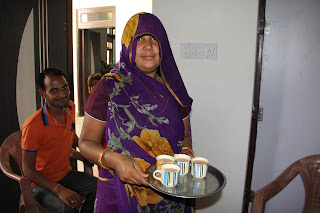With the upcoming Pujas, Diwali, and Christmas-New Years, I decided to take a trip out to Rajasthan and then onto Gujarat, in search of new handcrafted items from various artisans. It was in August and the monsoons were in full swing in Kolkata. I wondered how it would be in arid Rajasthan.
A very early morning flight out from Kolkata got me to Jaipur by 7:00am! I headed straight for the village of Blue Pottery, some 55kms outside of Jaipur. The weather was perfect! Not hot and not humid but quite pleasant. I had connected with this artisan potter family in June when I had come for a separate reason, which, I'll be writing about soon!
Vibrant, cute, fun, and creative blue pottery decor items were placed before me in this lovely home where I was greeted with smiles and a cup of steaming Rajasthani Masala Chai!! Door knobs, incense stick holders in the shape of a palm, little cute Turtles - all made using the unique technique of Blue Pottery!
The patriarchs in this artisan family were trained by Kripal Singh Shekhawat, the father of Blue Pottery. Kripal Singh is known to have been approached by Maharani Gayatri Devi and Kamala Devi Chattyopadhyay of Crafts Council, to revive Blue Pottery. A unique mixture of gypsum, quartz, glass and gum is used as the basis.
Once put in certain moulds, they are baked in the hot Rajasthan sun for a few days. Then the artisans paint various patterns on them and they are put in the kilns. Once the product comes out of the kiln, one can see the beautiful and vibrant colors of turquoise, navy, yellow, green come alive!
I picked up my loot of items for Maka Maka, and headed off to the village of Bagru, known for natural dye block printing and Mud resist printing! But before I left, my artisan friends made sure I had a plate of homemade "poha" (a snack made of flattened rice and vegetables) and another cup of sweet Rajasthani masala chai as they weren't sure when and where I would grab lunch!!
I love making such friends wherever I go!
A very early morning flight out from Kolkata got me to Jaipur by 7:00am! I headed straight for the village of Blue Pottery, some 55kms outside of Jaipur. The weather was perfect! Not hot and not humid but quite pleasant. I had connected with this artisan potter family in June when I had come for a separate reason, which, I'll be writing about soon!
Vibrant, cute, fun, and creative blue pottery decor items were placed before me in this lovely home where I was greeted with smiles and a cup of steaming Rajasthani Masala Chai!! Door knobs, incense stick holders in the shape of a palm, little cute Turtles - all made using the unique technique of Blue Pottery!
I picked up my loot of items for Maka Maka, and headed off to the village of Bagru, known for natural dye block printing and Mud resist printing! But before I left, my artisan friends made sure I had a plate of homemade "poha" (a snack made of flattened rice and vegetables) and another cup of sweet Rajasthani masala chai as they weren't sure when and where I would grab lunch!!
I love making such friends wherever I go!










.jpg)
.jpg)
.jpg)
.jpg)

%2B(607x683).jpg)

.jpg)
.jpg)
.jpg)
.jpg)
.jpg)

